Fascia
definition
Under Fascia one understands in common parlance the connective tissue coverings of the Musculature. They consist of tight, interwoven networks collagen connective tissue and from Elastin.
Inside the fascia there is a layer of thin, loose connective tissue. When preparing meat, everyone has probably come into contact with fasciae when pulling the thin, whitish skin from the muscle layers.
In the strict medical sense, fascia is understood to mean firm, flat plates of connective tissue, such as the foot fascia or the large back fascia.
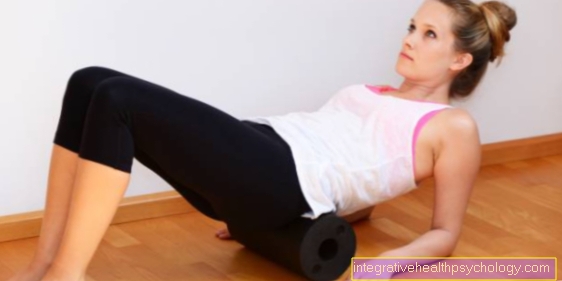
We find connective tissue as connecting structure everywhere in our body. Muscle fibers are "wrapped up" in connective tissue, joints and organs are protected by connective tissue capsules, ligaments, which also consist of fascial tissue, connect ours bone together.
The Body fascia are in so-called Fascia chains arranged that support each other because they are under tension. It therefore makes sense to treat entire fascia chains and not concentrate on a single section.
Fascia are no rigid tissue, that means that the tension of the fascia can change with every movement. Besides, the Fascia tension by the autonomic nervous system controlled. The various fascia tissues are all connected mechanically and through the autonomic nervous system.
Our thickest and strongest body fascia are located at the Heel - Achilles tendon and in the Lumbar spine - large back fascia.
History of fascia - What is the significance of fascia?
In the past, the fascia tissue was primarily called annoying packaging organ and filling fabric viewed. For a long time, when examining the fascia, one had to rely on the subjective perception of the subjects and the tactile sensation of the examiner.
For years, however, it has been possible, thanks to highly sensitive ultrasound devices and other modern examination methods, to measure the thickness and mobility of a fascia down to a tenth of a millimeter. Strength, elastic behavior and Water content of the fascia can nowadays be measured before and after exercise or therapeutic intervention.
Breakthrough discoveries are made in research by the Examination of the Achilles tendon been won. This tendon has highly elastic propertiesthat help people to walk with a springy gait, as the Achilles tendon can store and release energy like a catapult, similar to shooting an arrow after a pre-tensioned bow.
The strength and speed of the footprint is primarily dependent on the storage of the jumping energy and its sudden discharge. This effect was discovered in the kangaroos and used in the implementation of current running techniques and in the manufacture of artificial jump orthoses.
Appointment with ?

I would be happy to advise you!
Who am I?
My name is dr. Nicolas Gumpert. I am a specialist in orthopedics and the founder of .
Various television programs and print media report regularly about my work. On HR television you can see me every 6 weeks live on "Hallo Hessen".
But now enough is indicated ;-)
In order to be able to treat successfully in orthopedics, a thorough examination, diagnosis and a medical history are required.
In our very economic world in particular, there is too little time to thoroughly grasp the complex diseases of orthopedics and thus initiate targeted treatment.
I don't want to join the ranks of "quick knife pullers".
The aim of any treatment is treatment without surgery.
Which therapy achieves the best results in the long term can only be determined after looking at all of the information (Examination, X-ray, ultrasound, MRI, etc.) be assessed.
You will find me:
- Lumedis - orthopedic surgeons
Kaiserstrasse 14
60311 Frankfurt am Main
You can make an appointment here.
Unfortunately, it is currently only possible to make an appointment with private health insurers. I hope for your understanding!
For more information about myself, see Lumedis - Orthopedists.
anatomy
Superficial fascia lie directly below skin and subcutis and are very elastic and able body fat (if you gain weight or become pregnant).
Deep fascia lie under another layer of fat, they are less stretchy and less blood supply as superficial fascia and responsible for the transmission of pain.
An important component of the deep fascia are those Myofibroblasts. These are special connective tissue cells that are similar to the muscle cells of the smooth muscles, produce collagen and are able to react to mechanical or chemical stimuli with contraction and relaxation.
The Rigidity of the deep fascia probably depends on the Myofibroblast density from.
An extremely high proportion of myofibroblasts can be found e.g. at the Dupuytren (Disease in which there is a thickening and stiffening of the flexor tendons, accompanied by severe restriction of movement).
They are a special case Organ fasciathat envelop the organs. They are less stretchy and responsible for that Support function and Securing the organs. If the tension of the organ fascia is too loose, this leads to an organ prolapse, if the tension is too tight, the organs are impaired in their necessary sliding ability.
tasks
- connection: In the broadest sense, fascia form the connection between all body systems of the muscles, Tendons, Ribbons, bone, Joints, annoy, Vascular system and the hormonal system. You spin a whole-body network made of a grid-like structure that has no beginning and no end. This connecting tissue ensures that the various structures of our body are joined together and, like interlocking gears, also function as a whole system, provided that there is no disruption.
- Support function: Our body would not get through Fascia supported and held, he would collapse because the bones are just the basic structure. Fasciae connect all tissues with one another, but at the same time cause the mutual demarcation adjacent muscles and organs from each other and thus serve the sliding ability of the different tissues against each other. Due to their 3D elasticity, fasciae are extremely flexible and can therefore adapt to the most varied of loads.
- As passive structure the fascia gives the Muscle hold on contraction. You can get under heavy loads condense and in this way serves the Muscles as protection. By engaging the connective tissue in the muscular power transmission, the power of the muscles is applied to the tendon (transition of the muscle to the bone), so the power is not lost in the adjacent tissue.
- Protective function: The connective tissue network protects our body from injuries caused by external loads and foreign bodies and acts like a elastic shock absorberto cushion movements.
- The grid of the fascia forms after the skin largest sense organ our body. The density of those contained in the fascia Sensors (Receptors) is 10 times higher than in the muscles. Due to its high density of receptors, the fascia network forms a large sensory organ, the smallest changes in Tension, pressure, pain and temperature recorded and forwards the information obtained to the brain. The constant messages from the receptors present in the connective tissue help us to achieve good body awareness, through which we are able to perceive the position of all body parts in space and, if necessary, to change and adapt them. The large back fascia contains a particularly large number of pain receptors that extend from the neck to the back of the head.
- transport: All components of the Connective tissue swim in a viscous, 70% water-containing basic substance, the matrix. In this humid environment, the entire Mass transfer instead of. Fascia are filling tissues that store blood and water and act as a gateway for blood, Lymph fluid and serve nerves. When moving, the connective tissue reacts like a sponge that is squeezed out and which soaks up again in the relief phase. The decisive factor in this process is the replenishment of the tissue with fluid. nutrient become the place of need via the connective tissue transported and distributed. Become through the exchange to the venous and lymphatic system Waste materials again transported away. If the transport of substances in the connective tissue matrix is disturbed due to illness or a lack of exercise, the tissue thickens and “waste materials” accumulate.
- The fibroblasts enter the connective tissue matrix continuous renovation instead of. Fibroblasts are constantly producing new collagen and elastic fibers, which become solid connective tissue e.g. develop into tensile ligaments or loose filling tissue between the organs in the abdominal cavity, while old, worn-out structures are broken down again.
- cure: Hit the fibroblasts injured tissue, they react by overproducing collagen fibers and in this way can the Close wound. After the work is done, these cells die. However, if the healing process z. B. disturbed by an inflammation or if an area of the body is permanently overloaded, the fibroblasts continuously produce more collagen. The fiber chains knot, tangle and form small ones scar (Fibrosis), which results in pain and restricted mobility (e.g. painful frozen shoulder, frozen shoulder). Even with the growth and spread of Tumors Excessive collagen production plays a crucial role.
- immune system: In the fascia there are mobile cells of the immune system (Macrophages), which absorb everything in the connective tissue that has no or a damaging function. This includes dead cells, bacteria, Viruses and tumor cells. Phagocytic cells (Phagocytes) are able to remove pathogens via the lymphatic or venous system and thus play an important role in the Immune defense to take. Mast cells (Mastocytes) are particularly active in controlling Inflammatory processes.
Damage to the fascia
- Constant sitting, one-sided, recurring exercise habits or a lack of exercise
- Excessive demands and force effects on the connective tissue in everyday life or at work, or one-sided, excessive training loads, loads in sport, work-related, recurring movement sequences
- Injuries, surgery, inflammation
- Reaction of the connective tissue to stress messengers - hardening of the tissue due to the release of cortisol in the event of emotional stress
Damage from sedentary lifestyle
Quote Dr. Robert Schleip, fascia researcher: Fascia live from movement, those who do not move - sticky!
Our everyday life is more of Sedentary lifestyle, as shaped by movement. Constant sitting or standing, immobilization after injury or inflammation change the sliding behavior of the connective tissue. Years of unhealthy nutrition also have a negative effect on the connective tissue of the fascia.
The Need fascia similar to the muscles training for certain loads. This leaves the connective tissue and consequently the muscles and joints movable, extreme Loads are withstood without damageprovided the other structures are intact. The healthier and smoother the connective tissue in the back, the lower the pressure load on the small vertebral joints and on the Band washers.
On Sedentary lifestyle the connective tissue reacts with it Solidification through matting, the individual fibers are no longer arranged like a concertina mesh (like shrunk wool). Through the Bonding becomes that which takes place in the fascia Inhibited mass transfer, Movements become painful and restrict.
So-called bad crosslinks are formed, these are movement-restricting cross-links between the connective tissue fibers. Posture and muscle work suffer, those affected feel a general one Body stiffness ("As if everything is too short!"). The formation of crosslinks increases with age.
As long as the body maintains the rigidity of movement, the problem is only slightly noticeable.
But the body tries that usual posture the restriction of movement and pain quickly become apparent. By automatically avoiding painful movements, the body tries to prevent further distribution of pain signals. In this way, a vicious circle is set in motion, as the avoidance strategies trigger uneconomical movement sequences with the consequence of further functional restrictions and pain.
Movement inhibits pain, lack of exercise increases pain!
Damage from excessive exposure
Everyday, professional and sporting requirements should be the Do not exceed the load capacity of the connective tissue, whereby the tolerance, depending on constitution and training, differs individually for each person.
With persistent Overload or more permanent, unilateral burden or Overextension Constant, one-sided sitting postures lead to mini-injuries - Microtraumas- the connective tissue as soon as a sudden uncontrolled movement stretches the shortened and damaged fascia and stimulates the nerve endings that trigger pain. The Mini injuries add up on and on and in the long run lead to pain signals.
Before the injuries have healed and the fiber structure is strengthened again, further micro-traumas occur. Be in a row Inflammatory reactions triggered the one Voltage increase in the connective tissue and muscles, which in turn trigger renewed injuries. The damaged fascia shortens, scars, thickens and loses its ability to slide.
Damage from injury, surgery, or inflammation
By deeper tissue injuries, Inflammation or Operations arises Scar tissuebecause the organism is not able to renew the injured tissue in the same condition as it was before the injury. In particular, scar growths and scar ridges are caused by a reactive overproduction of connective tissue.
Typical properties of scar tissue are low elasticity and restricted functionality, especially if the scar lies over frequently moving joints and is therefore exposed to high tensile stress. Sticky and poorly elastic scar tissue often results in not only local movement restrictions and pain, but also functional restrictions that can affect the body as a whole.
Damage from stress
Unhealthy, persistent, mental stress solves reinforced Cortisol release (Precursor of cortisone) into the tissue. Permanently excessive cortisol release leads to a contraction in the connective tissue and Spasm of the connective tissue. This Indurations (Fibroses) in connective tissue are caused by the excessive increase in collagen fibers, tendons, ligaments, articular cartilage and intervertebral discs degenerate.
The tissue entanglement leads to a restriction of the exchange of substances, the permeability for nutrients and the removal of metabolic toxins is disturbed. The muscles that are dependent on the metabolism of the connective tissue are also damaged, and muscle mass is reduced.
Fascia Chronification
Due to the high nerve density in the fascia network, experiences that have left their traces through the release of certain messenger substances in the nerve cells of the connective tissue and in the brain are like in one Memory storage preserved.
Emotional trauma in childhood or adolescence can be partly responsible for later occurring pain in the muscles or the connective tissue, since our body on the old Pain pattern falls back insofar as it does not go through early and consistent treatment will be erased.
The fabric doesn't forget.
How do you diagnose fascia damage?
In the past, muscular tissue and joint mobility were primarily examined in the treatment of chronic back pain and treated with a wide variety of muscle relaxation techniques, joint techniques and strength building.
In the holistic diagnostics from Causes of pain and Pain therapy allowed to Muscles, fascia, joints, nerves and organs cannot be viewed independently of one another as they are inextricably linked. Muscle strength, mobility and joint function are always provided by a unit of muscle groups and the associated fascia, tendons, ligaments, joints and nerve connections.
For the Examination of the connective tissue are available to the therapist Anamnesis, posture, tactile and functional findings available as a diagnostic tool.
In the anamnese Through specific questions, the therapist learns the history, information on pain behavior, accompanying diseases and functional disorders in the musculoskeletal system.
At the Posture findings habitual and relieving postures can be recognized, constantly shortened areas and body sections that are under constant stretch are diagnosed and documented. Shortening and scarring or overstretching of the connective tissue on the one hand have local effects on the neighboring muscles and the neighboring joints, on the other hand global effects on the entire posture.
At the Palpable findings the state of tension and thickening of the connective tissue can be felt in a side comparison. Pain provocation localizes the painful areas.
With the Functional findings movement restrictions, pain-inducing movements and loss of strength are determined.
Increase in tension and thickening of the fasciae can be associated with highly sensitive ultrasound devices measured and verified.
What pain is triggered by the fascia?
Bonded fascia can trigger a very large number of different pains. You have to recall once again that the fasciae superficially surround all muscles, but that we also find them in connection with joints, bones and internal organs.
Because we do not use the fascia individually, but as one with each other connected system have to see a fascia bond Complaints in more distant places do. Pain in the back, neck and shoulder area is a big issue when it comes to fasciae adhesions. Due to the constant sitting at the PC, while reading and in front of the cell phone as well as the lack of compensatory movement, many people have adopted permanent bad postures, which are expressed in chronic pain. This problem can also be found in the back in the thoracic and lumbar spine area.
It is assumed by fascia specialists that many back complaints that are attributed to the intervertebral discs are actually caused by the fascia and reduced by regular stretching and fascia training could become.
Due to the tensile loads, there are often adhesions in the tendon plate on the outside of the thigh (the iliotibial tract). Constant sitting also results in fasciae adhesions as a cause of pain on the back of the thighs, the buttocks and in the lumbar spine area. Pain in arms and legs can be caused by adhesions of fascia in the area of the hips and shoulders, which affect the nerves and radiate into the hands and feet.
Since the fasciae are connected from foot to head, a disruption of the fascia in the feet can cause discomfort. The use of tennis or fascia balls to work on the soles of the feet can result in extreme improvements.
You might also be interested in: Connective tissue pain
Fascia as a cause of back pain
Chronic, unspecific back pain is characterized by muscle tension, stiff body regions, rest and stress pain. The pain is often increased in the morning after getting up or after sitting for a long time and often improves after light movement and everyday activities. In the evening after exercise, the pain returns with the rest phase.
Only about 25% of back pain is caused by disc tissue, nerve compression or inflammation. Cracks after strains or inflammations, so-called microtraumas (miniature injuries to the tissue) in the large-area fascia (e.g. large lumbar fascia in the lumbar area), ligaments and facet joints (small vertebral joints) are often used as pain triggers when non-specific pain occurs.
Microtraumas:
Microtraumas arise from unfamiliar everyday / professional one-sided permanent and excessive stress. An accident that has already been forgotten, an old sports injury, constant improper stress caused by "long-term sitting" in the office are put away by our bodies for years until pain occurs at some point due to excessive demands on the connective tissue. Intense, excessive training stimulus, especially with unusual sporting loads with eccentric muscle work (= sustained muscle work) also lead to mini-injuries in the muscle and connective tissue.
The body reacts to these tiniest tissue tears with its healing processes. Local inflammatory reactions result in changes in the cell structure of the connective tissue, which lead to hardening, sticking and reduced mobility of the fascial tissue. The result is pain and restricted mobility. Since the fascia - especially the large back fascia - are very densely populated by pain receptors with a low stimulus threshold and high sensitivity, they are considered to be a potential trigger of back pain. In patients with unspecific deep back pain, ultrasound examinations revealed a thickening of the large lumbar fascia, which disrupts the sliding behavior of the 3 layers of the fascia.
Performance requirements must not exceed the adaptability of the fabric!
local / global pain:
The fascial grid and thus all muscles, bones, joints and organs from the large foot fascia to the meninges in the skull consisting of connective tissue are connected to one another. For this reason, e.g. moving the arm the tension in the foot.
Fascial tension somewhere in our body results in changes in tension, overload and functional restrictions in other parts of our body, regardless of whether the damage to the connective tissue is acute or chronic. The balance of tension is disturbed, first local, then global problems arise. These "transmitted pain symptoms" are independent of the supply area of the nerves and must be taken into account during treatment.
An example of such a malfunction is the simultaneous occurrence of deep, lumbar back pain and radiation to the back muscles of the leg that is not caused by irritation of the sciatic nerve. Constant cramping in the hand due to PC work can lead to shoulder pain, small injuries in the knee can lead to back pain.
The fascia roll
Fascia rolls are suitable to even without a physiotherapist to loosen the fascia independently and to loosen adhesions. As the name suggests, they are roles that, depending on the design, consist of different materials and one certain surface structure as well as size (diameter).
They are also available as balls, balls or hedgehog balls. There are also different degrees of hardness for the fascia rolls. For Beginner it is better to use low or medium degrees of hardness to begin, otherwise the "rolling" could be too painful. When it comes to the surface structure, a distinction can be made between smooth and structured fascia rolls. In the case of the structured roles, the elevations result in point loads that have a more intensive effect that also extends into deeper layers.
There are also roles with Grooves and recesses, so that the back can be worked on, for example, and the spine is spared through the groove and not burdened. In addition, there are roles in which a vibrating core can be used, whereby the depth effect is then to be increased. Ultimately, there are still roles in different sizes. Larger roles are also suitable for larger muscle areas such as the thigh. And for smaller areas, such as parts of the arms, rather small roles.
Basically, depending on the application, smaller rolls can also be used for larger areas. On the market for fascia rolls there are a large number of providers with a wide variety of special skills. The rule is that one slowly in the application enter should, and also not directly need all variants of roles.
Appropriate advice can be obtained from an orthopedic specialist shop. Otherwise, so-called entry-level packages can also be found on internet sales platforms with which one can learn to roll with fascia. If you are rather unsure, you should seek more detailed advice. In many fitness and health centers special fascia courses are offered.
Fascia ball: approx. 12 cm diameter, solid, recyclable foam
Fascia roll: approx. 15 cm in diameter, solid foam that can be recycled in different degrees of hardness
Small fascia roll: approx. 4 cm in diameter, 10 cm in length, firm, recyclable foam
See also under: Fascia roll or Blackroll
Fascia training
The idea of Fascia training is based on the assumption that the Fascia with age and with lack of exercise over time stick together and felt. This leads to long-term and chronic bad posture, which leads to pain and discomfort.
The fasciae can through regular exercise with a Fascia roll loosened and softened again. By using a fascia roll, the tissue is better supplied with blood, metabolic processes that have occurred are increasingly transported away and adhesions can be loosened in the long term and pain can also be alleviated.
Fascia training is described in various papers and textbooks. It is not a process that can be mastered from now on. There are different views from experts on how and in which directions and at what intervals to roll. Basically, however, that 5 minutes a day followed by 5 minutes of stretching have a long-term effect demonstrate.
The act of rolling can be painful and uncomfortable, for example on the outside of the thigh. That is absolutely he wishes and should be in the next few weeks Use regularly to improve. The rule here, however, is that there should be no pain that still causes discomfort after the application has ended! Then you should contact your family doctor or physiotherapist to avoid injuries from incorrect training.
The training can be in different Courses learned and be internalized. But if you want to try the training on your own, you get a lot of fascia rolls Explanatory videos included.
If there are orthopedic or other diseases that affect the stability of the bones, you should first start with one Doctor discussed whether fascia training is an option or whether it should be avoided for health reasons.
General information can be found at: Fascia training
How can I loosen fascia adhesions myself?
You can definitely do it yourself. There is a regular use of the Fascia roll (approx. 5 minutes daily) necessary.
The principle is that the Roll on the floor and that you then deal with the affected body region on the roller. For example, if the outside of the thigh is affected, you would lie on the roll with it, straighten your back and support your feet and forearms. The next step is now that through a Rolling motion is rolled over the roll of the thigh from the hip to the knee. This is done with approx. 8-12 reps, there and back.
It is important that the exercise is carried out calmly and with feeling. How much weight or strength you put on the roller depends on how painful the rolling process is. At the beginning of the training it may well be that you can lie down on the roller with very little strength. After several uses it should be less uncomfortable and you can put more weight on the roller.
These instructions can be used for other body regions. The roller manufacturers recommend around eight exercises for the whole body. By rolling regularly, the aim is to loosen the adhesions. Since the process of Fascia adhesions not a short term process, such as sore muscles, and about one a long period of time accordingly, it also takes time for the bonds to loosen.
Self-help by rolling out - Self myofascial release
Self-massage, relaxation, improvement of the exchange of substances and regeneration of the fasciae and muscles
The pressure on the tissue, which is sometimes quite painful from the outside, increases the water absorption and the gliding ability of the tissue layers - especially between muscles and connective tissue - among each other. The tissue is literally squeezed out by the pressure; when the pressure is released in the relaxation phase, the tissue is refilled. The sensors located in the fascia for the position of the body in space are activated and body perception improves.
The rolling out of muscles and fasciae is used as a warm up before training, but also as a cool down after training. The pleasant feeling after rolling out makes it easier to start exercising. Due to the increased exchange of substances in the tissue and the improved body awareness, injuries are prevented.
Rolling out after exercise stimulates the stressed structures to regenerate more quickly.The cool down is slower and more intense than the warm up.
Fascial rolling out as pain treatment:
During the preparation of the tissue by loosely rolling it out several times, pain points are detected through concentration and body awareness. Even if the treated area is actually pain-free, pain points are often perceived when rolling out, which disappear over time with regular and consistent self-treatment.
As a cost-effective self-help device for the self-treatment of fascial adhesions and muscular trigger points, the fascia ball and fascia roller (alternatively Pilates roller, but is a little softer and more manageable) can be used sensibly.
Practice: execution and dosage
- 10-15 times loosely, as evenly and harmoniously as possible, rolling out the fascia to prepare the tissue
- Concentration on perceiving the areas being worked on, feeling pressure, resistance and pain
- afterwards, intensely, slowly (1cm / breath) and with pressure, "roll out" areas where you feel pressure and tension; Work into the pain or the "well-being" until the point becomes softer and feels more comfortable. Localization, pressure and speed are regulated by the practitioner himself
- Repeat 2-3 times a week for approx. 15-20 minutes
- Always start at the foot fascia, then continue to work up the body, remaining in painful areas
- Rolling out can be done in preparation for training or as a massage after training to achieve relaxation.
- To roll out and work on painful areas, the large or small fascia roller or the fascia ball (more punctual and more intense) is used, depending on the area and the desired intensity
- Variations can be achieved through different starting positions and the degree of hardness of the individual devices. In the case of high pain intensity, start with softer rollers and in a standing position so that the full body weight is not placed on the areas to be worked on.
Exercise examples for rolling out with the fascia roller:
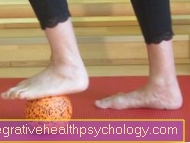
Starting position: standing, feet parallel, fascia ball under one foot, possibly. rest one hand on a sturdy armchair for safety
Execution of the exercise: preparatory and perceptual rolling out and treatment of the painful areas under the sole of the foot, in the middle, inner and outer areas of the foot according to the above scheme
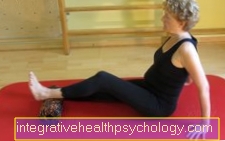
Starting position: Sitting on the mat, the Achilles tendon lies on a large or small fascia roller, the hands are supported on the mat
Exercise execution: preparatory and perceptive rolling out and processing of the painful areas on the Achilles tendon, in the middle, inside and outside according to the above scheme
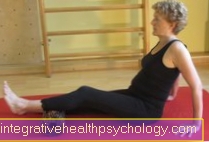
Starting position: Sit on the mat, hands propped up on the mat, calf lies on a large fascia roll
Execution of the exercise: preparatory and perceptual rolling out and working on the painful areas on the calves by rolling back and forth on the roller, in the middle, inside and outside according to the above scheme (you can also roll out both calves at the same time if you support yourself with your hands)
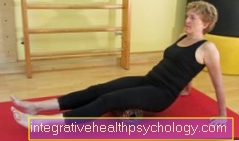
Starting position: Sit, hands supported, the back of the thighs lie on a large fascia roll
Execution of the exercise: preparatory and perceptive rolling out and processing of the painful areas in the back of the thigh area by rolling back and forth on the roller, in the middle, inside and outside according to the above scheme
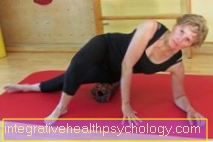
Starting position: lying on your side on the mat, lower leg extended,
the upper leg is angled with the foot in front of the lower leg on the floor, the large fascia roll lies under the hip area
Execution of the exercise: roll out the lateral thigh area from the hip to the knee
Alternatively: Stand on the belt, roll between the pelvis and wall, roll out the lateral thigh area by doing small squats
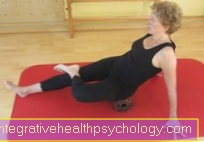
Starting position: Sit on the large fascia roll, possibly kneeling a leg in order to reach inside and outside of the buttocks, hands supported
Execution of the exercise: Rolling out and working on the painful areas of the buttocks by moving back and forth on the roller, in the middle, inside and outside by shifting your weight to one side according to the above scheme
To increase the intensity, you can also sit on the fascia ball.
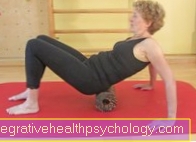
Starting position: sitting on the mat in front of the roll,
large fascia roll lies under the lumbar area
Exercise execution: rolling out and processing the large back fascia by moving back and forth over the roller,
Put your hands behind the roll on the floor and roll out according to the above scheme
Alternatively: Stand against the wall, roll between the lower back and the wall, roll out the lumbar area by doing small squats
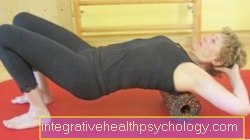
Starting position: Sit on the mat, large fascia roll lies under the thoracic vertebra area, hands clasped behind the head
Execution of the exercise: Roll out and work on the thoracic vertebra area down to the lower neck area by moving back and forth over the roller according to the above scheme
Alternatively: Stand against the wall, roll between the lower back and the wall, roll out the thoracic vertebra area by doing small squats
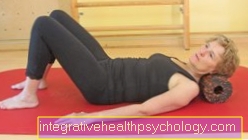
Starting position: Sit on the mat, large fascia roll lies under the neck, hands lie next to the body, legs are up
Exercise execution a: Unrolling and processing of the skull base by rolling the head sideways according to the above scheme
Exercise execution b: Unrolling and processing the base of the skull by moving the head back and forth according to the above scheme
Alternatively: Stand on the wall, roll or ball lies between the neck and the wall, roll out the base of the skull by making small lateral rolling movements of the head
Caution: if the neck area is more sensitive or if you have a tendency to headaches, start these exercises very carefully and increase the dosage if your pain tolerance improves.
Multimodal therapy
Goal: Relaxation through myofascial balance and free mobility of the body
A wide variety of therapeutic options are recommended for the treatment of fascial pain symptoms. The following topic explains the structural treatments of the fascia and sports therapy in more detail.
- holistic survey and investigation
- Education and information
- structural treatment of the fasciae and muscle chains
- Segmental manual therapy in the corresponding spine segment
- Physiotherapy and sports therapy
- drug therapy, neural therapy
- Psychological pain behavior therapy
- Meridian therapy (kidney meridian) e.g. with acupuncture or APM (acupuncture massage according to Penzel)
- Foot reflexology therapy
Passive fascia therapy
Through the Passive physiotherapeutic forms of treatment of the connective tissue and the muscles, the patient is very responsive to the sports therapeutic training prepared. If individual connective tissue layers are stuck together and thickened, the muscles connected to this area are not able to function properly, i.e. these muscles can neither be optimally trained nor can they regenerate accordingly. Without the appropriate preparation, those affected would have to constantly fight the high tissue tension, the pain and the Restrictions on movement struggle.
Rolfing
Rolfing - also under the name Structural integration known - was developed in the 50s by the biochemist Ida Rolf and named after her. This made her one of the first researchers to highlight the importance of connective tissue for the economic straightening of the body in addition to the muscles.
The method is not aimed exclusively at medical problems, but wants to facilitate the straightening of the body against gravity by treating adhesions and hardening in the fascia grid Prevent postural pain. In addition to preventive medical care, Rolfing Therapy is used to treat poor posture, chronic back pain and structural changes.
The therapy consists of manual techniques and sensorimotor exercises. Psychosocial factors are also taken into account in treatment. After more thorough Analysis of posture While standing and sitting, the therapist feels, assesses and treats the structure of the connective tissue. The manual techniques use fingertips, thumbs, knuckles, palms, and elbows, depending on the region to be treated and the required depth slow pressure exerted on the connective tissue. Then the exercises and everyday economic processes are taught and corrected.
Rolfing is usually called Series of treatments of 10 consecutive 50 - 90 minute sessions in a treatment period of approx. 3 months.
Contraindications: Injuries with open wounds, acute inflammatory diseases, phlebitis, osteoporosis, Pregnancy, degenerative muscle disease, mental illness and long-term Taking cortisone, Implants
FDM: Fascial distortion model according to Typaldos
The term Fascial distillation model is made up of the words fascia (bundle) and distortion (twisting and dislocation). This diagnosis and therapy method was developed by the US doctor and osteopath Stephen Typaldos, who presented it in 1991. This treatment method is primarily based on years of experience in the examination and therapy of acute and chronic pain patients with a wide variety of diagnoses.
Typaldos assumed that behind the pain pictures of the patients 6 different fascial distortions conceal with reproducible description templates. An FDM therapist must have excellent visual and palpatory (Tactile ability) perception, as each of the 6 fascial distortions - twisting, shifting, sticking, calcifications of the connective tissue - feels different and this is only due to the anamnese, the inspection of posture and body language, a functional test with pain provocation and palpation to be diagnosed.
The treatment takes place manually With different large-area and punctual fascia techniques depending on the spoilage, which are quite painful for the patient, but ultimately leave a feeling of relaxation and pain relief. Since symptoms improve during treatment, the therapist can immediately check his diagnosis through tests.
In addition, cupping therapy and active self-stretching of the affected areas can be used in the time between treatments.
Contraindications: acute injury or inflammation, osteoporosis, high blood pressure, Heart attack
Myofascial taping
Myofascial taping offers one sensible addition to passive and active fascia therapybecause the tape remains on the body for a while and can work there if no other form of treatment is used.
A special myofascial tape is used, similar to the well-known kinesiological functional tapes, but with stronger adhesive and less retraction force, as strong tension is often required. By applying the tape with appropriate tension, the affected fascia is shifted in the direction that the fascia has the greatest possible relaxation and pain reduction - myofascial release- brings.
The application technology and the pull depend on the structural quality of the fascia and its location determined in the findings (restricted movement, pain findings and palpation findings). By keeping the tape on the skin - an average of 5 days with 2-3 days of recovery for the skin between the 2-3 tape systems can a long-term effect can be achieved.
Also read: Kinesio tape
Active functional training
After the intensive preparation of the fascia chains by rolling them out and treating the pain points, active fascia training is carried out for sustainable self-help. Many of the exercises (e.g. stretching exercises, functional strength exercises) are known, but are carried out in fascia training under different training criteria.
For fascia training there is also the Blackroll, which is currently very popular with many.
Pain Relief Through Movement:
In the connective tissue and muscles, the mechanoreceptors - movement receptors - are activated in the tissue as well as through passive movement and active movement. Their activity "overlay“The activity of the pain receptors and let the signals of the pain receptors increasingly take a back seat, provided that the cause of the pain is not structural changes in the musculoskeletal system or an acute inflammation. Movement relieves muscular and fascial tension, pain tolerance increases and confidence in the body's resilience increases again. Many pain sufferers have this positive experience. Movement helps!
Every healthy person lives with it genetic differences in bone structure, muscles, connective tissue, gender and age, as well as with different loads in everyday life, work and sport. People with a more stable physique, strong muscles and poor mobility should focus their training on dynamic stretching techniques. Delicate people with less strength, but above-average mobility (often it is "hypermobile“Women) should focus their training on targeted functional strength training from a fascial point of view.
In the Physiotherapy or sports therapy do we already have "pre-damaged“To do people who are already burdened with local or global movement restrictions and pain. The Exercise program should be designed under the guidance of a physiotherapist or sports therapist according to the existing damaged structures and the individual performance level with a high fun factor and flexibility.
Offer another option special fascia courses for groups that are part of the Rehabilitation sports or in Physiotherapeutic practices Tobe offered. There the exercises are shown and checked under the guidance of specialist staff.
General training recommendations:
- 2 - 3 training units per week, already 2 units / week of 10 minutes are better than nothing
- Exercise at a lower intensity if you have complaints
- Course of a training session: 1. Warm up with a fascia roll and / or loose, expansive movements, elastic stretching, 2. Functional strength exercises, 3. Fascial stretch
- Regeneration and relaxation with running out, relaxing movements, fascia roll, ball
- Pain-free Training except for the muscle pull at the end of the movement, otherwise it is advisable to simplify the sequence of movements
- Sufficient Work breaks with loosening, relaxing motion sequences between the stress
- Slow increase in exertion under good control of movementConcentration and body awareness with every exercise, quality before quantity
- Calm, steady breathing rhythm in the execution of the movement
- Training focus with poor mobility and good strength: dynamic stretching
- Focus of training with good mobility, but low strength and stability: functional strength training
- Variable design of training
- Fun , Patience and continuity should not be neglected
Contraindication:
- Inflammation attack the connective tissue structures, wait for healing
- Operations, Wait for the healing process, start training again after consulting a doctor
- To Strains or other Injuries The elasticity of the connective tissue only reaches its full tensile strength again after 6-12 months, resumption of training after medical advice and careful start with a slow increase
- Infections weaken the body, intensive training should be suspended
Rocking stretches - warm up
After the general warm-up to rhythmic music (approx. 110-120BPM) with expansive, three-dimensional exercise sequences with coordinative requirements, exercises with elastic, elastic, rhythmic elements, aimed specifically at the fascial spiral lines, are carried out. The movement sequences are reminiscent of gymnastic exercises from the 1960s.
These forms of exercise have been replaced by functional gymnastics and rather static stretching exercises, which mainly propagated "safe, axially correct exercises" for fear of uncontrolled shear forces on the joints. The return to the springy, rhythmic exercises is based on the fact that the target tissue - the fascia - is an elastic and therefore largely tear-resistant network.
At the end of the range of motion achieved, small, controlled springy movements, so-called mini-bounces, are performed. This activates all fiber parts of the already stretched muscle and the spiral structures of the fascial grid.The aim is to stimulate the supply of connective tissue by increasing the flow speed through the supply of heat through movement. By pushing and pulling during the exercises, more collagen is produced by the fascia cells. As a result, the grid-like structures of the connective tissue align better, and stability and elasticity increase.
Exercise examples:
The elasticity of the fascial grid is responsible for how economical our energy consumption is during active loads. Since the connective tissue is able to store kinetic kinetic energy through pre-tension and release it again like a catapult when moving, the muscle work, which is characterized by high energy consumption, is supported and thus relieved. In a trained person, the proportion of active muscle work decreases with a simultaneous increase in collagen suspension. Increased performance in sport and energy-saving, economical everyday movements are therefore not exclusively due to increased muscle strength.
Especially in sports, the risk of injury can be reduced through springy, loosening, stretching exercises while warming up (no static, long-lasting stretching before training).
The use of the stored kinetic energy in the spring movement of the feet and legs is particularly evident. Apart from the "start contraction" of the muscles at the beginning of the movement, no more muscle activity can be measured in the further course. The further sequence of movements is carried out by the passive structures, in particular the Achilles tendon.
Swing movements are understood to mean the increase in the spring movement. It is important that the swing movement is not carried out exclusively with the help of gravity, but that the elastic energy at the reversal point is used. The spine and the knee and hip joints move with the swing movement of the arms.
Jumps are a further increase in bouncy movements. They are only possible through a good coordination of muscle contraction and support of the passive tissues. Because of the high pressure and shock loads on the spine, jumps are not always suitable as a form of training in the event of previous orthopedic damage.
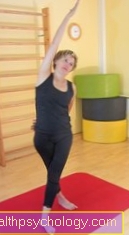
Starting position: Stand with legs apart, right arm pulls over the head, left arm is hidden behind the back
Exercise 1: Leaning of the upper body from standing to the left with soft rebounding from the end position, changing sides
Exercise execution 2: in the starting position also cross behind the right leg, stretch to the left, rocking to the side, changing sides
Exercise execution 3: in the exercise execution, extend the lateral inclination with a forward inclination of the upper body in front of the body axis or backward inclination behind the body axis
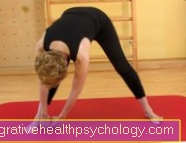
Starting position: Stand with legs apart
Exercise: starting with the cervical spine, slowly roll your back vertebrae by vertebra and strive towards the floor with your fingertips, then reduce the distance between fingers and floor by gently rocking up and down, stretching towards the middle, towards the right or left foot
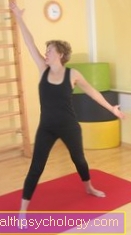
Exercise execution: pull with the right hand towards the left foot
(if the leg muscles are shortened, bend the knee slightly),
then stretch the right arm slightly upwards and outwards,
Head and upper body rotate with
the left arm is stretched backwards behind the body axis at the same time
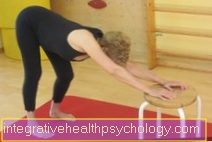
Starting position: Stand with legs hip-width apart in front of a stool, both hands are placed flat on the stool
Exercise execution: slightly bend one leg, stretch the other leg, at the same time push the corresponding half of the pelvis towards the ceiling
Strength training with a catapult effect - rebound elasticity
Our muscles are networked in muscle chains on the one hand, and integrated in the fascia system on the other. Newer scientific findings about the interaction of muscles and connective tissue are changing the current training principles. Maximum power can only be achieved by pre-tensioning the fascial tissue, as the connective tissue is able to store kinetic energy and then catapult-like (Catapult effect) to release again.
In addition, the connective tissue can relieve the muscles and reduce energy consumption by supporting the holding work. This phenomenon was originally discovered in the Australian kangaroos and is used in modern strength training. The catapult effect saves muscular energy in the trained, while the proportion of collagen suspension increases. This allows the movement sequences to be carried out more economically.
When walking and running, one of our most economical movement activities, the proportion of the catapult effect via the connective tissue is very high, the muscle length remains almost constant. Muscle mass is therefore not the only factor in generating strength and increasing it, but rather the cooperation of the muscles with well-trained, tear-resistant connective tissue and the optimal timing of the catapult effect. A high level of coordination is required for this.
Practice: exercise examples
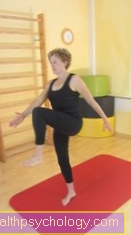
Starting position: step position, the front leg bent, the toes on the back leg
Exercise execution: pull the back leg forward to the stomach with a strong footprint,
Return to the starting position in order to let the leg "snap" forward again to the stomach with a firm footprint. The sequence of movements takes place at a fast pace with a constant rhythm. The arms move in opposite directions at the same speed.
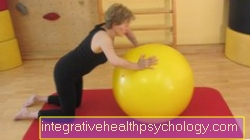
Starting position: kneeling in front of a Pezzi ball
Exercise execution: let the body weight fall forward and cushion it with both hands on the Pezziball, repeat in a fast, constant rhythm
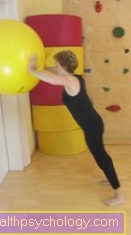
Starting position: Stand with sufficient distance in front of the wall,
a pezzi ball in both hands
Exercise execution: let the body weight fall forward and cushion it with the Pezzi ball on the wall, repeat in a fast, steady rhythm
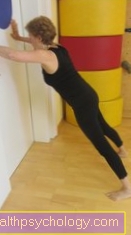
Starting position: Stand with legs hip-width apart in front of a wall
Execution of the exercise: with weight shift of the body forward, both hands are supported on the wall at the same time, the body is brought back to the starting position with a strong hand print, the body does not bend in the hip area, but remains stretched. The sequence of movements takes place at a fast pace with a constant rhythm.
Starting position: Stand with legs apart, feet slightly turned outwards
Execution of the exercise: start from the squat for a small jump, bring your feet into a stretching position, softly catch the jump in the squat and start straight back to the next jump at a constant pace and rhythm.
Attention: the exercise is only possible if the load on the intervertebral discs and spine is tolerated by the jump
Functional strength training
Functional strength training is a holistic training method that achieves all components of physical fitness. Strength, endurance, endurance of the cardiovascular system, flexibility, coordination and stability are trained in multi-dimensional movement sequences instead of subjecting individual muscle groups to isolated training.
Functional strength training has established itself in many areas as well as in popular and competitive sports and should always be tailored to the age, performance, current complaints, daily form, and the motivation of the participants.
Principles:
Training of movement sequences:
In functional training, multi-articulated muscle groups and in different planes of movement are used, as every body movement is three-dimensional and always multi-axis (not uniaxial as in many power machines). It is exercised while observing the kinetic chain reaction and the interaction of all muscles, fasciae and joints involved in a sequence of movements. In particular, the emphasis is on the rotational (body turning movements) movement components, as these movements occur very often in everyday life and the body must be well trained for them.
The control of turning movements, often in combination with bending movements, is essential to prevent injuries and pain. Body weight and mostly free weights are used as resistance in functional training to increase strength endurance and muscle building. The exercise sequences are designed to be dynamic and variable. Exercise selection and sequence with changing body positions and return to the center of the body after the sequence of movements keep the connective tissue supple.
Principle: Train movements, not muscles!
The functional strength training includes exercises for the global, anatomically superficial moving muscle system, as well as exercises for the local, anatomically deeper, stabilizing muscle system. At first glance, the small targeted stabilization exercises seem not very functional because they are characterized by sustained tension components and simple movements with slow, small movement amplitudes.
Good stabilization muscles are the prerequisite for joint stability and for coordinated, economical movement sequences and are often insufficient (weak and not well coordinated). Stabilization means by activating the deep muscle system - left - maintaining a neutral body position against gravity before the start of the movement and during the movement. Joint protection is ensured by activating the local, deep muscles near the joints.
Since the exercises for the deep muscle system can only be carried out with full attention, they are particularly useful for training perception.
Starting movement after stabilization means turning on the deep muscle system before starting a multifunctional strength exercise.
Dosage of functional strength training:
The effectiveness of strength training depends on the optimal training dose, which in turn depends on the objective of the strength training. Do I want to achieve more endurance, high-speed strength, or maximum strength (less in physiotherapy, but in competitive sports)?
The focus of strength training with an emphasis on fascial components is strength endurance, the exercise execution is predominantly dynamic. In fascia training, special attention is paid to body awareness during strength exercises. Each exercise should be performed dynamically, in a coordinated manner and with full concentration. There are no fixed stimulus parameters. The exercise stimulus is determined individually by the exerciser.
Through intensive feeling during the exercise, the practitioner feels the strain in the muscles and decides for himself when he feels the strain is sufficient for himself. This affects the feeling during the exercise, but also afterwards during the break from exertion. In order to set a training stimulus, a clear feeling of exertion must be felt.
The following training parameters can be used as variables:
- Stimulus intensity of the force required
- Stimulus duration of the individual exercise
- Movement quality: without evasive patterns to the full extent of movement
- Stimulus density: relationship between stress and relaxation (breaks between the individual exercises and series)
- Stimulus range: repetition of the individual exercises and the exercise series
- Training frequency per week
The stress stimulus depends on the individual training status, which should be regularly determined by a physiotherapist or sports therapist so that the stress intensity can be regularly adjusted to the current status. If the stress is subliminal (below 40%), there is no training effect, slightly over-threshold training stimuli maintain the performance state (50-60%), over-threshold stimuli increase the level of training (60-70%), excessive performance demands damage the organism.
The dosage decides on the adequate training stimulus, which is necessary to set in motion adaptive positive adjustment processes in the optimal case. This training stimulus goes to the limit of individual exercise tolerance. Microtraumas triggered by the training stimulus lead to a reactive cell structure in muscle and connective tissue cells, the normal cell structure is followed by a cell structure above the normal level.
A good marker for the dosage is the feeling of strain during the exercises. If the feeling occurs: it is no longer possible, always add 3 repetitions, always provided that there is no pain other than the feeling of exertion in the muscles.
Overload: If the training stimulus (or too high everyday and / or workload) is too high for the individual load tolerance, fascia and muscle cells are damaged. Most sports injuries are of a fascial nature - sore muscles, strains, fiber tears, ligament injuries or overload syndromes can be classified as both muscles and fascial injuries. Sore muscles and fasciae are difficult to distinguish for those affected, as the so-called sore muscles are not only caused by mini-injuries in the muscle cells, but also show signs of inflammation in the connective tissue. The latter in particular makes up the main pain.
Slow rolling out with the fascia roller, loose movement and careful, active stretching support rapid regeneration in the case of sore muscles.
Training stimulus too low: no training effect!
Training stimulus too high: tissue damage!
Training continuity:
In order to adapt the increase in performance beyond the original performance level, the organism needs recovery times. If the next training session takes place too soon after the last stress phase, the body reacts with exhaustion and the risk of injury increases. If the breaks are too long, the body loses the gain in performance. In order to maintain stable and functional results, training must therefore be continuous. The longer the period in which the performance build-up has taken place, the lower the performance decrease during the breaks. In fascia training, a load frequency of 2 / week is recommended so that the tissue has enough time to recover.
Exercise examples for functional strength training:
All exercises are performed dynamically as a sequence of movements!
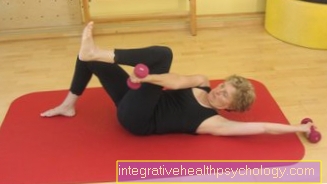
Starting position: Lie on your back, arms long back next to your head, a dumbbell is in each hand
Execution of the exercise: at the same time pull the right arm forwards past the left, raised, angled leg, lifting the head and shoulders, changing sides
Exercise execution 2: in the case of neck problems, the head can be supported with the left hand when lifting the upper body

Starting position: Lie on your back, a Pezzi ball is wedged between your thighs and your feet
Execution of the exercise: both knees are pulled towards the stomach with the ball, try with a slight swing to pull the knees further towards the shoulder, lying in the middle, right / left, head and shoulders as relaxed as possible
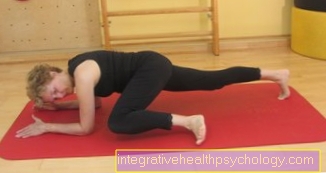
Starting position: forearm support, legs open hip-narrow and stretched with the toes, the body is raised in a line parallel to the floor
Exercise execution: alternately bend one leg and pull the knee sideways towards the shoulder,
the head looks to the knee at the same time
Exercise 2: Increase, the exercise can also be performed from the hand rest
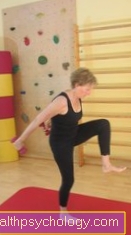
Starting position: big step position, the arms are behind the body axis, 1 dumbbell in each hand
Exercise execution 1: the back leg is pulled forward to the stomach, while both dumbbells are lifted with stretched arms towards the ceiling at the same time
Exercise execution 2: the arms are raised at the beginning of the exercise and at the same time as the leg is raised, they are stretched far behind the center of the body
Three-dimensional stretching
Multifunctional slow stretching with alternating vectors:
In fascia training, the springy, dynamic stretching exercises (preferred for warm-up) as well as the variably designed slow, three-dimensional stretching techniques from changing starting positions are justified.
With axially aligned, "static" stretching - left - only a certain area of the muscles and fasciae is reached, other tissue areas are neglected.
With the slow “static” stretching techniques, it makes more sense to design the starting positions and exercises so flexibly that the stretching reaches the problem areas of the practitioner in a more targeted and individual manner. The stretching techniques should contain playful elements and should be carried out with a special focus on body awareness.
Practice: A basic exercise is given, the practitioner feels during the execution: Where do I feel the most tension? What changes? When I stretch statically or rhythmically, when I turn my foot inwards or outwards, when I support my back the exercise bend or stretch.According to the individual feeling of stretching, the exercise is then changed as needed. It should always be stretched softly, "melting down" and in combination with the breathing - not in a cramping manner, but rather breathing to the stretching without exaggeration or false ambition. Since the fascia network is the body's largest sensory organ, it is important to train body awareness when performing the stretching exercise through intensive sensing. Since the stretch tolerance limit is better perceived in this way, the risk of injury can be reduced.
Many yoga exercises meet the criteria: spiral, diagonal or lateral modification of the stretching exercise.
The holding period of the stretch has been debated for years. A stretching success can already be measured after 10-15 seconds, the usual holding time of the stretching exercises is approx. 45 seconds, increases of up to 2 minutes. are possible.
Yield strength:
No matter which stretching technique is used, there is always an individual stretch limit. If this resistance is overcome with "excessive ambition", injuries are the result. This stretch resistance above a certain stretch is due to the muscle connective tissue and the tendon and tendon plates. By repeatedly practicing with high stretching intensity with good "feeling", the stretching tolerance can be increased in the long run. With increasing stretching amplitude, the effect on the fascial and muscular structures increases, the cell tissue is remodeled and develops into a more flexible, well-ordered fiber grid with an extended range of motion.
After stress during an exercise, there is always sufficient relief through loosening movements so that the tissue can recover and fill up with fluid. Movement sequences that are not monotonous, but multidimensional and varied, promote the filling of the tissue and the exchange of substances after the load.
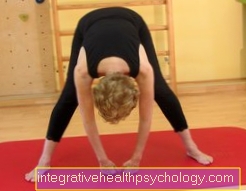
Example: Bending the trunk with straight legs, stretching the back of the thighs and the large lumbar fascia
Starting position: standing with extended knee joints
- Legs closed, open or crossed
- Feet turned inside or outside
Exercise execution:
- Stretch straight forward or sideways by twisting your torso
- Bring your arms back through your legs
- Back bent or straight
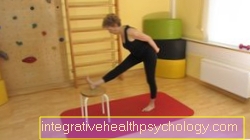
Starting position: upright position, one heel rests on a stool with the knee extended
Exercise execution 1: the upper body is stretched and bent straight forward over the long leg
Exercise execution 2: the left hand pulls the outside of the right ankle
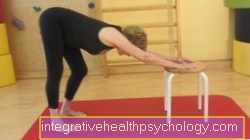
Starting position: Stand with legs wide open, both hands are supported on a sturdy stool, the knees are stretched
Exercise execution: alternately bends and extends one knee, while the pelvis on the same side is pushed towards the ceiling, the spine describes an expanding sideways movement.
Body awareness relaxation - Sensory Refinement
Since fascia as a sensory organ has a very high density of receptors (measuring sensors), these diverse receptors should be addressed and sensitized by adequate sensory movement components, otherwise they wither away. The stimulation for the receptors can be achieved by pressure stimuli e.g. with fascia roll or ball (intense or gentle), pulling stimuli e.g. for swing exercises with small weights and vibrations e.g. with the Galileo - link can be designed variably.
In addition, the fascial training should contain as many sensorimotor movement components as possible. Sensorimotor functions (cooperation of the sensory systems with the motor systems) provides the basis for controlling the muscles and thus for economic movement control. Appropriate movement components (slow, sensitive, focused exercise) train deep sensitivity and body awareness, the sense of position, strength and movement, and neuromuscular coordination within the muscle and muscle chains.
Movement perception: The full attention of the test persons is an important component of the movement execution in order to optimally perceive the movement sequence and the reactions of the tissue. The better our perception system is trained for movement, the more coordinated and economical the control of the muscle chains for a movement sequence can be. Injuries, pain and lack of exercise can reduce awareness in certain areas of the body.
Learning to feel the fascia system and increasing your body awareness is reflected in improved well-being. The term embodiment says how well we feel at home in our body.
Without sensorimotor there is no training stimulus!
Balance training: Keeping your balance means controlling your body's center of gravity despite different, unpredictable influences (e.g. a shock) over a support surface (e.g. both feet on the floor). Strengthening the sense of balance - LINK and depth sensitivity is an important factor in fascia training. Elderly people in particular benefit from balance training; the fear of new movements reduces the risk of falling.
Relaxation of the fascia after exercise:
- Loosening, soft movements, leaking
- Roll out the body with the fascia roller
- Selective rolling out with a tennis ball or fascia ball
Exercise examples for selective rolling out with the ball:

Starting position: sitting on a stool, feet hip-width apart
Test: open your mouth as wide as possible, possibly in front of the mirror
Exercise: roll out the muscles with a tennis ball in circles at both temples and directly below the temporomandibular joint with gentle pressure
Retest: open your mouth wide again and watch for changes

Starting position: standing, feet hip-narrow
Test: raise both arms maximally towards the ceiling, possibly in front of the mirror
Execution of the exercise: with a tennis ball on both sides with gentle pressure, roll out the large pectoral muscle in circles, slowly work through the entire muscle, vary the pressure as you feel, you should feel good.
Retest: raise both arms up towards the ceiling, watch out for changes


Starting position: seat, feet hip-narrow
Test: turn your head as finely as possible from one side to the other, pay attention to a feeling of tension
Execution of the exercise: Have a partner roll out the shoulder and neck muscles with a tennis ball, circling selectively and slowly working through the muscles bit by bit, varying the pressure as you feel, you should feel good.
Retest: turn your head back to both sides, watch out for changes
Alternatively, if no partner is available:
Starting position: Stand against a wall, the ball is between the wall and the shoulder muscles
Exercise execution: by pressing the body weight against the ball the muscles with small,
in circular movements, the movements are triggered by knee flexion and extension.




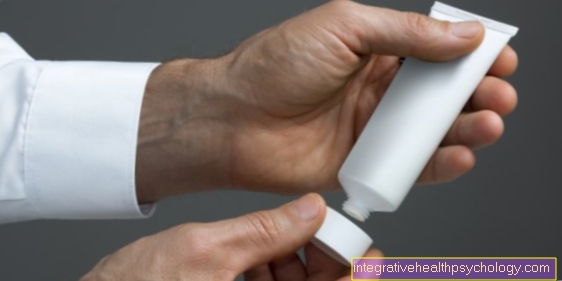

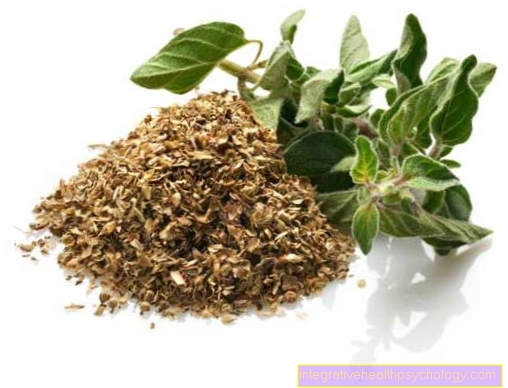





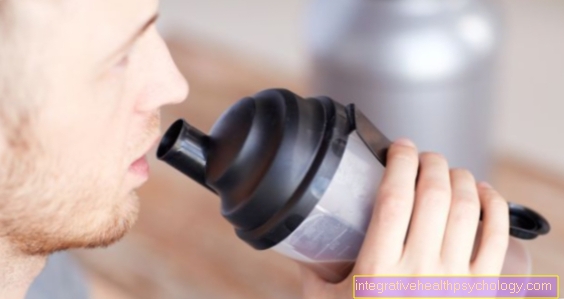


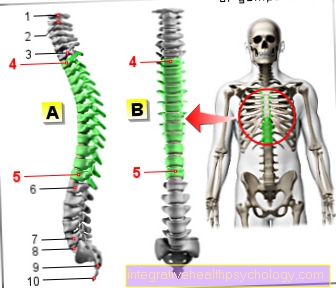

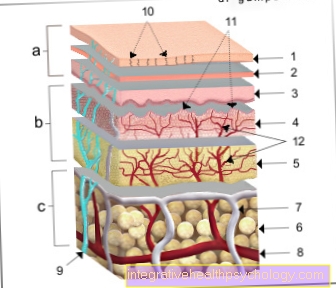
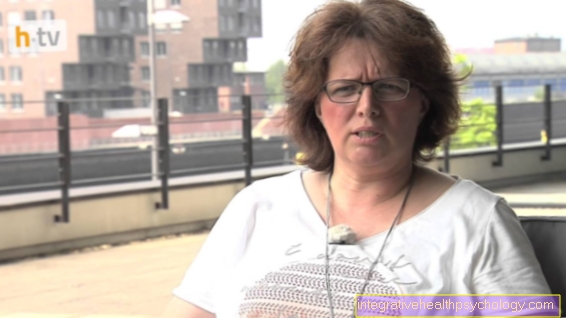



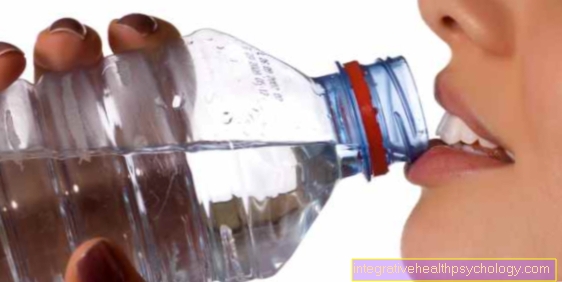
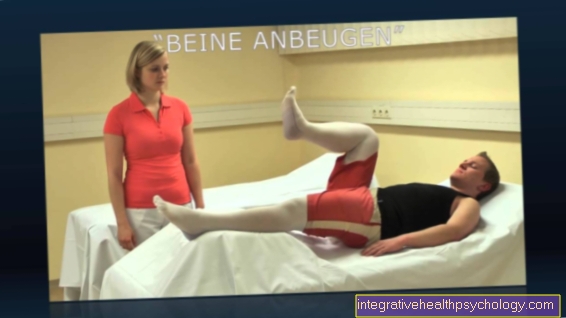


.jpg)


